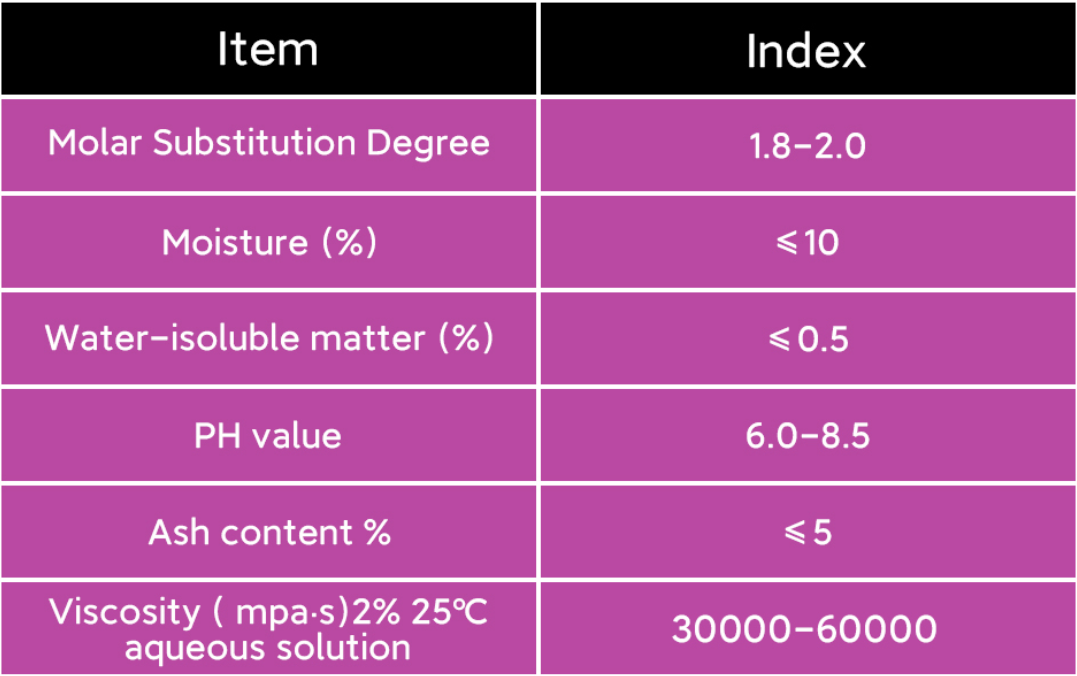
![]()
HEC introduction
Hydroxyethyl cellulose (HEC) is a white or light yellow, odorless, non-toxic fibrous or powdery solid. It is prepared by the etherification reaction of alkaline cellulose and ethylene oxide (or chlorohydrin). Nonionic soluble cellulose ethers. Because HEC has good thickening, suspension, dispersion, emulsification, adhesion, film-forming, moisture protection and protective colloid properties, it has been widely used in petroleum mining, coatings, construction, medicine and food, textiles, papermaking and polymers. Polymerization reactions and other fields. 40 mesh sieving rate ≥99%;
HEC Molecular Structure:

HEC Physicochemical Properties
1. Melting point: 288-290℃(dec.)
2. Density: 0.75 g/mL at 25℃(lit.)
3. Softening temperature: 135-140℃
4. Expressed density: 0.35-0.61g/ml
5. Decomposition temperature: 205-210℃; burning speed is slow
6. Equilibrium temperature content: 23℃; 6% at 50%rh, 29% at 84%rh.
7. Appearance: This product is white to light yellow fibrous or powdery solid, non-toxic and odorless.
8. Solubility: H2O: ≤5 wt. % at 20℃, easily soluble in water. Insoluble in general organic solvents. It has the properties of thickening, suspending, bonding, emulsifying, dispersing, and retaining moisture. Solutions of different viscosity ranges can be prepared. Exceptionally good salt solubility in electrolytes.
9. The viscosity changes little when the pH value is in the range of 2-12, but the viscosity decreases beyond this range. It has the properties of thickening, suspending, bonding, emulsifying, dispersing, retaining moisture and protecting colloids. Solutions of different viscosity ranges can be prepared. It is unstable under normal temperature and pressure, avoid humidity, heat, and high temperature. It has extremely good salt solubility in dielectrics. Its aqueous solution allows high concentrations of salts to remain stable.
HEC Data Sheet

Main Usage
application
Main application areas
Used as adhesives, surfactants, colloid protective agents, dispersants, emulsifiers and dispersion stabilizers. It is widely used in the fields of coatings, inks, fibers, dyeing, papermaking, cosmetics, pesticides, mineral processing, oil extraction and medicine.
1. Generally used as thickeners, protective agents, adhesives, stabilizers and additives for preparing emulsions, jelly, ointments, lotions, eye cleansers, suppositories and tablets. It is also used as hydrophilic gels and skeletons. Materials, preparation of matrix-type sustained-release preparations, and can also be used as a stabilizer in food.
2. Used as sizing agent in the textile industry, bonding, thickening, emulsifying, stabilizing and other additives in the electronics and light industry sectors.
3. Used as a thickener and fluid loss agent for water-based drilling fluids and completion fluids, and has obvious thickening effect in salt water drilling fluids. It can also be used as a fluid loss reducer for oil well cement. Can be cross-linked with multivalent metal ions to form a gel.
4. This product is used in water-based gel fracturing fluid for petroleum fracturing, and as a dispersant for polymers such as polystyrene and polyvinyl chloride. It can also be used as latex thickener in the paint industry, hygroscopic resistor in the electronics industry, cement retardant and moisture retaining agent in the construction industry. Ceramic industry glazing and toothpaste adhesives. It is also widely used in printing and dyeing, textile, papermaking, medicine, health, food, cigarettes, pesticides and fire extinguishing agents.
5. Used as surfactant, colloid protective agent, emulsion stabilizer for emulsions such as vinyl chloride and vinyl acetate, as well as tackifier, dispersant and dispersion stabilizer for latex. Widely used in coatings, fibers, dyeing, papermaking, cosmetics, medicine, pesticides, etc. It also has many uses in oil exploration and machinery industries.
6. Hydroxyethyl cellulose has surface activity, thickening, suspension, adhesion, emulsification, film formation, dispersion, water retention and protection in pharmaceutical solid and liquid preparations.
7. Dispersants used in the mining of petroleum water-based gel fracturing fluids, polyvinyl chloride, polystyrene and other polymers. It can also be used as a latex thickening agent in the paint industry, a cement retardant and moisture retaining agent in the construction industry, a glaze agent and a toothpaste adhesive in the ceramic industry. It is also widely used in industrial fields such as printing and dyeing, textile, papermaking, medicine, health, food, cigarettes and pesticides.
Folding product performance
1. HEC is soluble in hot or cold water and does not precipitate at high temperatures or boiling, giving it a wide range of solubility and viscosity properties, as well as non-thermal gelling properties;
2. It is nonionic and can coexist with a wide range of other water-soluble polymers, surfactants, and salts. It is an excellent colloidal thickener for high-concentration dielectric solutions;
3. The water retention capacity is twice as high as that of methylcellulose, and it has better flow regulation;
4. Compared with the recognized methylcellulose and hydroxypropylmethylcellulose, HEC has the worst dispersing ability, but the strongest protective colloid ability.
Dissolution Method
Since the surface-treated hydroxyethyl cellulose is powder or cellulose solid, it is easy to operate and dissolve it in dissolved water as long as the following matters are paid attention to.
1. Before and after adding hydroxyethyl cellulose, it must be stirred continuously until the solution is completely transparent and clear.
2. It must be slowly sieved into the mixing barrel. Do not add large amounts or directly add the hydroxyethyl cellulose that has formed into blocks or balls into the mixing barrel.
3. Water temperature and PH value in water have a significant relationship with the dissolution of hydroxyethyl cellulose, so special attention must be paid.
4. Never add some alkaline substances to the mixture before the hydroxyethyl cellulose powder is warmed by the water. Raising the pH value after it has warmed up will help dissolve it.
5. Add antifungal agents as early as possible.
6. When using high-viscosity hydroxyethyl cellulose, the concentration of the mother liquor should not be higher than 2.5-3%, otherwise the mother liquor will be difficult to operate. Post-processed hydroxyethyl cellulose is generally not easy to form lumps or spheres, nor will it form insoluble spherical colloids after adding water.
Packing,Transportation Note
Paper-plastic composite bag, lined with polyethylene film inner bag, net weight per bag: 25kg.
During storage and transportation, it should be protected from sunlight, rain, and moisture.